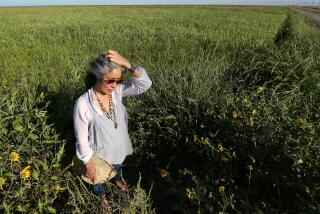Wild Rice Not Wild, Not Rice--Says USDA
WASHINGTON — Ah, the natural, exotic aroma of wild rice as it cooks with freshly bagged duck, pheasant or quail.
The only thing, says the Agriculture Department, wild rice “is usually not wild and it’s definitely not rice.” What then?
“Wild rice is really a grain more akin to oats than rice, and most of it is now cultivated in commercial paddies,” says a report by the department’s Economic Research Service.
It’s called rice mainly because of appearance, according to Barbara Stucker, an agency rice analyst. The brownish seed resembles a kernel of long-grain rice.
Also, like long-grain rice, wild rice is the seed of an aquatic grass and grows in shallow water similar to the irrigated paddies of long-grain rice, she says.
The wild rice report is in the current issue of Farmline, a monthly magazine published by the USDA agency. It said wild rice has become big business.
Most Grew Naturally
“Until about 20 years ago, most wild rice grew naturally in the lakes and slow-moving streams of northern Minnesota and bordering Canada,” the report said. “The crop was harvested by native Americans--members of the Ojibway Indian tribe--who processed it using traditional methods passed down from their ancestors.”
The Indians usually sold or traded the wild rice locally, although a small part of the crop always ended up on the gourmet market.
Today, boxes of wild rice and mixtures of wild and long-grain rice are common on supermarket shelves. And there is hope the market can develop further, according to Reynold Dahl, a professor of agricultural economics at the University of Minnesota, St. Paul.
Dahl says U.S. cultivation of wild rice began in Minnesota in 1967 and in California as recently as 1976. The two states account for all U.S. commercial production. As far as world output, Canada is the only other producer.
In 1965, the report said, total U.S. production of wild rice was 435,000 pounds and Canada’s output was 12,000 pounds. Last year, U.S. production was 5.55 million pounds and Canadian output 840,000 pounds.
Firm Encourages Production
Dahl said that wild rice cultivation was helped along by the interest of Uncle Ben’s Inc., a leading long-grain rice processor, which had developed a packaged mixture of wild rice, long-grain rice and herbs.
The company would go along with national marketing only with a dependable supply of wild rice, he said. As a result, Uncle Ben’s began contracting with three Minnesota farmers to plant acreages of new varieties developed by the university. From 900 acres, the state’s crop has grown to more than 25,000 acres. And that doesn’t count production from Minnesota’s lakes and streams.
More to Read
Sign up for Essential California
The most important California stories and recommendations in your inbox every morning.
You may occasionally receive promotional content from the Los Angeles Times.









